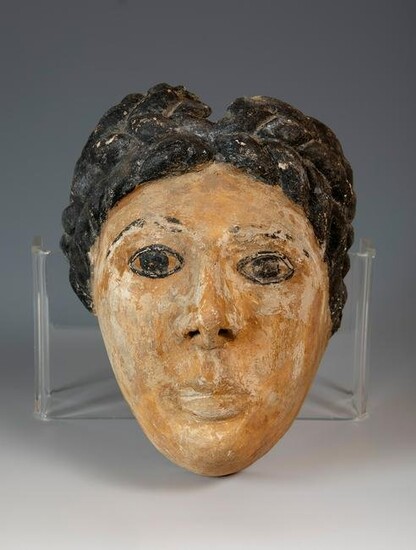Mummy mask. Ancient Egypt, Roman Period 20 BC- 1st
Mummy mask. Ancient Egypt, Roman Period 20 BC- AD 1st century.
Stucco and pigments.
Provenance: private collection in Holland, acquired in 1960.
In good state of preservation.
Measurements: 19 cm (height).
Ancient Egyptian funerary mask, in polychrome stucco, belonging to the Roman period. The main function of Egyptian funerary masks was to allow the identification of the deceased, which is why they were placed covering the head of the mummy. In addition, Chapter 151 of the Book of the Dead recalls that the funerary mask is an essential element in the protection of the head of the deceased. The first funerary masks were the stone "reserve heads" of the 4th Dynasty, which served as a substitute for the head of the deceased. Excavations have uncovered a number of plaster masks from the end of the Late Antique Empire, moulded over the face of the deceased in order to preserve their memory. The royal masks, most often made of gold, were often decorated with semi-precious stones and fragments of vitreous paste. The mask is therefore an important part of the funerary rites of Ancient Egypt, forming part of an elaborate series of rituals that were considered necessary to ensure immortality after death. These rites and protocols included mummification, the casting of magical spells and the inclusion of very specific objects in the tombs, which were thought to be needed in the afterlife.
Estimate
Time, Location
Auction House
Mummy mask. Ancient Egypt, Roman Period 20 BC- AD 1st century.
Stucco and pigments.
Provenance: private collection in Holland, acquired in 1960.
In good state of preservation.
Measurements: 19 cm (height).
Ancient Egyptian funerary mask, in polychrome stucco, belonging to the Roman period. The main function of Egyptian funerary masks was to allow the identification of the deceased, which is why they were placed covering the head of the mummy. In addition, Chapter 151 of the Book of the Dead recalls that the funerary mask is an essential element in the protection of the head of the deceased. The first funerary masks were the stone "reserve heads" of the 4th Dynasty, which served as a substitute for the head of the deceased. Excavations have uncovered a number of plaster masks from the end of the Late Antique Empire, moulded over the face of the deceased in order to preserve their memory. The royal masks, most often made of gold, were often decorated with semi-precious stones and fragments of vitreous paste. The mask is therefore an important part of the funerary rites of Ancient Egypt, forming part of an elaborate series of rituals that were considered necessary to ensure immortality after death. These rites and protocols included mummification, the casting of magical spells and the inclusion of very specific objects in the tombs, which were thought to be needed in the afterlife.



